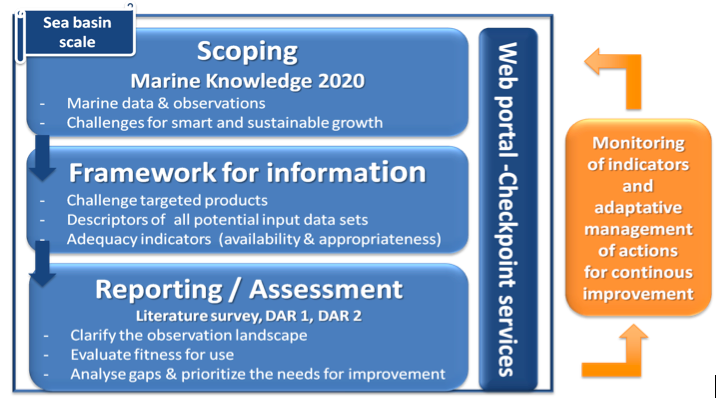Targeted Audience

EU initiatives supporting the blue economy
The integrated checkpoint service was driven by two types of access/usage, one public and one restricted for project use (challenges partners, experts and contributors). The public service primarily served a range of potential stakeholders, from institutional policy-makers, to data producers and data providers to help improve the adequacy of existing monitoring systems for the scope of the EU maritime strategy. They are the main usage drivers.

The checkpoint audience
For institutional policy makers, the checkpoint service should provide support for steering committee and decision making on observations monitoring and data management / dissemination infrastructure. This has been done by developing checkpoint e-services ingesting metadata and delivering indicators and statistics for identifying priorities, by challenge, by category of characteristics, by level of data after transformation process, and any type of relevant criterion (e.g. geographical area, elevation range, period of time, resolution…), highlighting gaps of the monitoring in addition to fact sheets and expert reports with proposed solutions.
For the other stakeholder categories, it should help highlight how their collected data could fit other uses than their initial purpose, or demonstrate the potential of innovative applications thanks to the availability of upstream data sets. To this end the checkpoint challenges analysed the fitness-for-use of the upstream data according to the requirements they specified to produce the thematic products mandated by the EMODnet tender. The regional checkpoint has thus developed checkpoint e-service with indicators providing feedback on the availability and appropriateness of the upstream data described in the checkpoint catalogue all need information to evaluate fitness for use.
Terminology Used
The Assessment framework
This customer-required approach for a user-view quality assessment led the Mediterranean checkpoint to design and implement an assessment framework which supports the checkpoint concept, a system and service solution to objectify, standardize and attempt to quantify the evaluation results (SMART indicators).
The general synopsis of the checkpoint concept is shown in the figure below: from scoping it goes to an information framework and to reporting quality and gaps using web tools and services.
The implementation is based on :
- The quality concept of ISO 9000 as the “Degree to which a set of inherent characteristics fulfills requirements” describing how to apply the concept to assess the adequacy of the input data sets and the challenge products making use of them,
- The INSPIRE Directive for the European Spatial Data Infrastructure, and the ISO standards for Geographical Information (ISO 19115 “Metadata, ISO 19157 “Data Quality” and ISO 19131 “Data Product Specification”),
- The use of dictionaries of the SeaDataNet European marine data network for parameter identification and classification,
- The definition of specification of needs for production (so-called DATA PRODUCT SPECIFICATIONS) and the definition of quality indicators (that is upon completeness, logical consistency, thematic accuracy, temporal quality and positional accuracy.) and following the SMART principles (Significant, Measurable, for Actionable information, Reproducible, Time-bound /managed for enhancement)
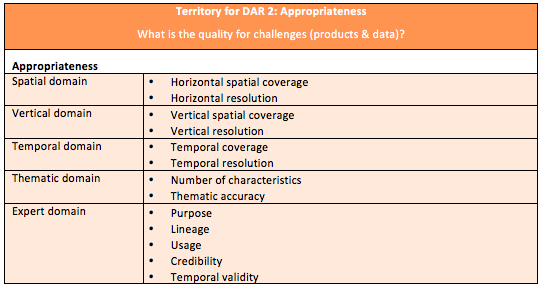
- 3 technologies leverage :
- A GIS database for the cataloging the source data and products including links between requirements for making the products, assessment on product realized (so-called TARGETED DATA PRODUCT) and input data used (so-called UPSTREAM DATA);
- A dashboard tool for aggregating and scoring raw metadata and indicators of GIS database and computation of statistics in order to offer a dynamic and synthesised display to allow non-expert public to easily assess the fitness for use without spending a lot of time looking at metadata and checkpoint reports;
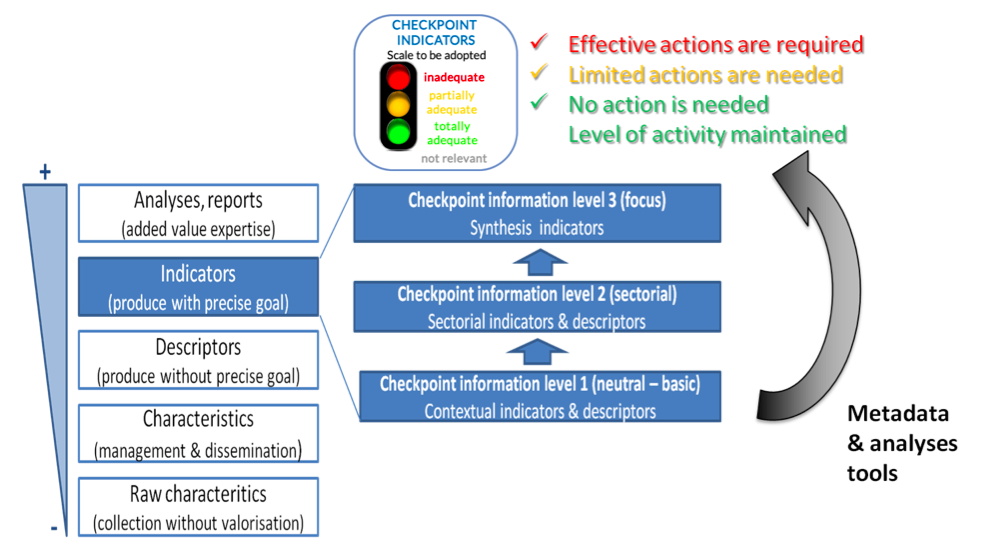
- A web service for visualization of GIS map layers;
- A workflow process as shown below:
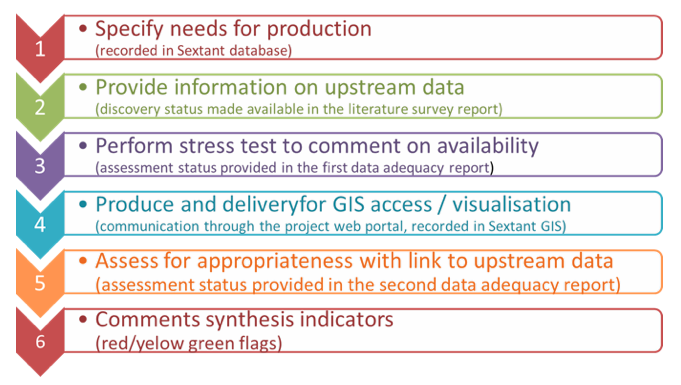
For the time being the implementing tools have a twofold capacity within the project:
- As internal tools for the data management team to run analysis and report on the data landscape,
- As an interface with the outside world, with a focus on data providers but also serving the wider research and industry community.
They were designed to enable users to rapidly check issues about, and progress in data adequacy which can be seen as threefold:
- Data gaps: where is monitoring lacking?
- Insufficient assembly: data sets remain scattered
- Data sourcing issues: access to data is difficult.
The availability indicators
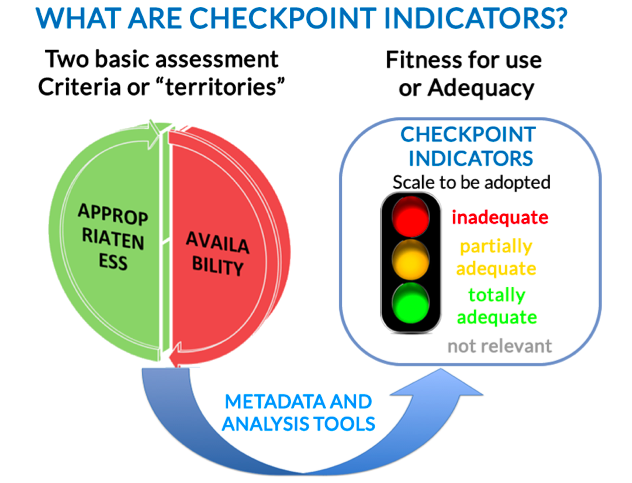

The checkpoint activity produced 3 levels of information, dated at the date of the assessment
- Level 1 is related to the raw and neutral descriptors of input data and the release of the targeted products of challenges.
(At this level, one can already identify the role and synergies of the input data.)
- Level 2 are targeted products and sectorial indicators to give feedback on the availability and the appropriateness status per challenge.
(Note here that the availability status is neutral and valid for all challenges.)
- Level 3 are checkpoint results, composed of the checkpoint e-service to search for and present synthesized and focused indicators and checkpoint expert reports on the fitness for use of the observing infrastructure (literature survey and data adequacy).
(Indicators answer precise questions but cannot be interpreted without the added value comments and expertise published in the reports.)
FAQs
- What are marine regions or subregion?
A specified area or sub-area of Europe’s seas, as defined within the Marine Strategy Framework Directive. These are specific instances of sea-basins. Recognizable geographical area of marine waters, often confined by land to form a distinct body of water.
- What is a challenge?
The challenges are tasks that have been chosen in order to make the bridge with end-user applications and to test how comprehensive and accurate the monitoring and forecasting data sets are at a sea basin scale. They cover the energy and food security sector (renewable energy, fisheries & aquaculture management), marine environmental variability and change (climate change, eutrophication, river inputs, bathymetry, alien species), emergency management (oil spills, fishery impacts, coastal impacts) and preservation of natural resources and biodiversity (connectivity of Protected Marine Areas and red list species), 11 areas altogether:

For more information on challenges see Challenges Section.
- What are input data sets?
These refer to the collection of existing data used as input to Challenges. Data is collected by an instrument at a particular place and time and which typically are repeated periodically to monitor change over time. It may be raw or processed to make it interoperable with other data.
Many of them are assembled and shared thanks to the European Marine Observation and Data Network (Thematic Assembly Groups), the Copernicus programme, the Data Collection Framework for Fisheries but others are made available in national and international databases.

